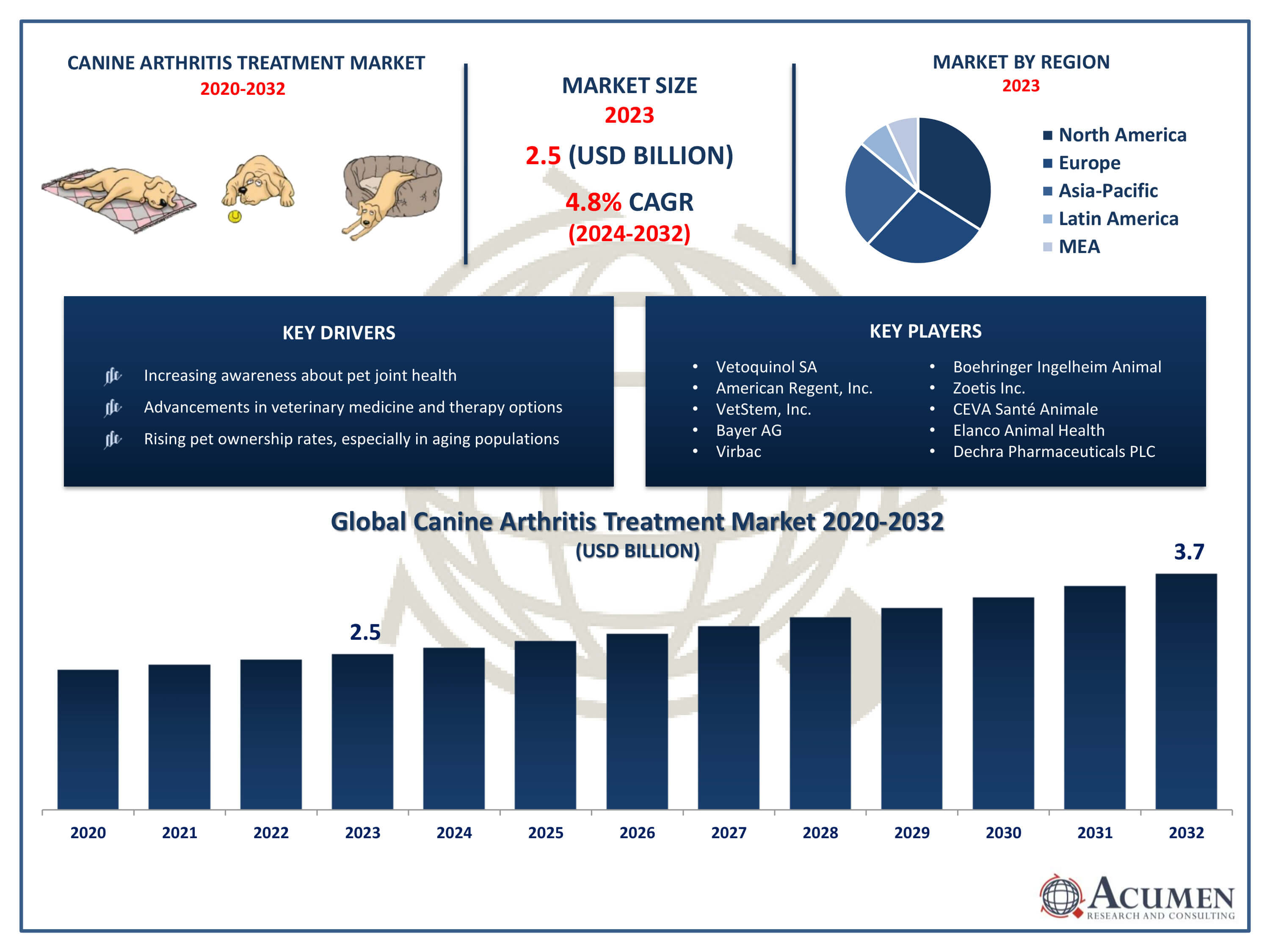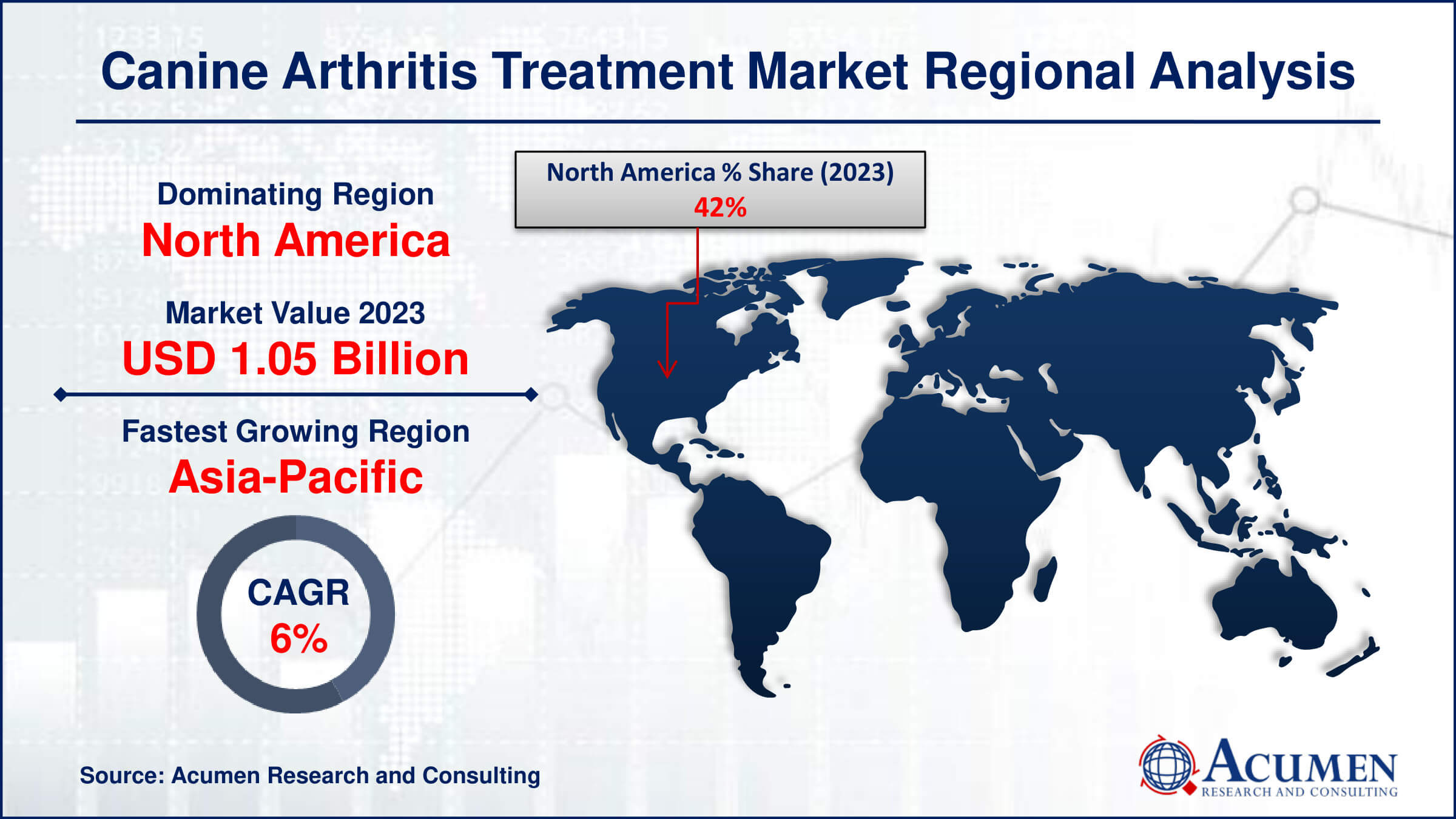Canine Arthritis Treatment Market Size - Global Industry, Share, Analysis, Trends and Forecast 2024 - 2032
Published :
Report ID:
Pages :
Format :
Canine Arthritis Treatment Market Size - Global Industry, Share, Analysis, Trends and Forecast 2024 - 2032
Report Coverage
- Industry Dynamics
- Market Size and Forecast Data
- Segment Analysis
- Competitive Landscape
- Regional Analysis with a Niche Focus on Country-Level Data
- High Level Analysis - Porter's, PESTEL, Value Chain, etc.
- Company Profiles of Key Players
- Option to Customize the Report As Per Your Specific Need
Request Sample Report
The Canine Arthritis Treatment Market Size accounted for USD 2.5 Billion in 2023 and is projected to achieve a market size of USD 3.7 Billion by 2032 growing at a CAGR of 4.8% from 2024 to 2032.
Canine Arthritis Treatment Market Highlights
- Global canine arthritis treatment market revenue is expected to increase by USD 3.7 Billion by 2032, with a 4.8% CAGR from 2024 to 2032
- North America region led with more than 42% of canine arthritis treatment market share in 2023
- Asia-Pacific canine arthritis treatment market growth will record a CAGR of more than 5.6% from 2024 to 2032
- By treatment type, the drugs are the largest segment of the market, accounting for over 44% of the global market share
- By arthritis type, the osteoarthritis is one of the largest and fastest-growing segments of the canine arthritis treatment industry
- Increasing awareness about pet joint health, drives the canine arthritis treatment market value

Canine arthritis treatment encompasses a range of approaches aimed at managing the pain and inflammation associated with arthritis in dogs. These treatments typically include medications such as nonsteroidal anti-inflammatory drugs (NSAIDs), corticosteroids, and pain relievers. Additionally, therapies such as physical therapy, acupuncture, dietary supplements like glucosamine and chondroitin, and weight management strategies may also be utilized to improve the dog's mobility and quality of life. In severe cases, surgical options like joint replacement or arthroscopy might be considered.
The market for canine arthritis treatment has been witnessing steady growth in recent years, driven by several factors such as the introduction of novel therapies, increasing investments in research and development, and the growing adoption of pets in emerging markets are anticipated to further propel market growth. Additionally, the trend towards premiumization in the pet care industry, with pet owners willing to spend more on high-quality healthcare products and services for their furry companions, is likely to positively impact the market dynamics. Moreover, the growing pet population, particularly in aging demographics, has contributed to the increased prevalence of arthritis in dogs, thereby driving the demand for arthritis treatments.
Global Canine Arthritis Treatment Market Trends
Market Drivers
- Increasing awareness about pet joint health
- Advancements in veterinary medicine and therapy options
- Rising pet ownership rates, especially in aging populations
- Growing demand for improved quality of life for pets
- Expansion of complementary and alternative therapies
Market Restraints
- High cost associated with advanced treatment options
- Limited accessibility to specialized veterinary care in certain regions
Market Opportunities
- Development of innovative treatment modalities
- Integration of technology for remote monitoring and telemedicine
Canine Arthritis Treatment Market Report Coverage
| Market | Canine Arthritis Treatment Market |
| Canine Arthritis Treatment Market Size 2022 | USD 2.5 Billion |
| Canine Arthritis Treatment Market Forecast 2032 |
USD 3.7 Billion |
| Canine Arthritis Treatment Market CAGR During 2023 - 2032 | 4.8% |
| Canine Arthritis Treatment Market Analysis Period | 2020 - 2032 |
| Canine Arthritis Treatment Market Base Year |
2022 |
| Canine Arthritis Treatment Market Forecast Data | 2023 - 2032 |
| Segments Covered | By Treatment Type, By Arthritis Type, And By Geography |
| Regional Scope | North America, Europe, Asia Pacific, Latin America, and Middle East & Africa |
| Key Companies Profiled | Vetoquinol SA, American Regent, Inc., VetStem, Inc., Bayer AG, Virbac, Boehringer Ingelheim Animal Health, Zoetis Inc., CEVA SantéAnimale, Elanco Animal Health, Dechra Pharmaceuticals PLC, and Nutramax Laboratories Veterinary Sciences, Inc. |
| Report Coverage |
Market Trends, Drivers, Restraints, Competitive Analysis, Player Profiling, Covid-19 Analysis, Regulation Analysis |
Canine arthritis treatment encompasses various therapeutic approaches aimed at managing the symptoms and improving the quality of life for dogs suffering from arthritis, a prevalent degenerative joint disease. The treatment regimen typically involves a combination of medications, supplements, physical therapy, weight management, and in some cases, surgical interventions. Nonsteroidal anti-inflammatory drugs (NSAIDs) are commonly prescribed to alleviate pain and inflammation associated with arthritis. Joint supplements containing ingredients like glucosamine and chondroitin sulfate may also be used to support cartilage health and improve joint function. Physical therapy techniques such as therapeutic exercises, massage, and hydrotherapy can help enhance mobility, reduce stiffness, and strengthen muscles around the affected joints. Additionally, maintaining a healthy weight through dietary management is crucial for minimizing stress on the joints and slowing down the progression of the disease.
The canine arthritis treatment market has been experiencing notable growth driven by various factors. With an increasing awareness of pet health and the desire for enhanced quality of life for companion animals, pet owners are seeking effective solutions to manage arthritis in their dogs. This growing demand is bolstered by advancements in veterinary medicine, which have led to the development of a diverse range of treatment options, including medications, supplements, physical therapy, and surgical interventions. Additionally, the expanding pet ownership rates, particularly in regions with aging populations, contribute to the rising prevalence of arthritis in dogs, further fueling the demand for treatment solutions. Furthermore, the market growth is sustained by the emergence of innovative therapies and technologies aimed at improving the efficacy and accessibility of canine arthritis treatment. Integrating telemedicine and remote monitoring capabilities allows for more efficient and convenient care delivery, especially in underserved areas.
Canine Arthritis Treatment Market Segmentation
The global canine arthritis treatment market segmentation is based on treatment type, arthritis type, and geography.
Canine Arthritis Treatment Market By Treatment Type
- Drugs
- Corticosteroids
- Non-steroidal anti-inflammatory drugs (NSAID’s)
- Opioid pain relievers
- Others
- Supplements
- Methylsulfonylmethane
- Glucosamine
- Chondroitin
- Others
- Surgical procedures
- Others
In terms of treatment types, the drugs segment accounted for the largest market share in 2023. Nonsteroidal anti-inflammatory drugs (NSAIDs) remain the cornerstone of pharmacological management, offering effective pain relief and inflammation reduction for dogs suffering from arthritis. The steady introduction of new NSAID formulations with improved safety profiles and longer durations of action has expanded treatment options, catering to a broader spectrum of canine patients. Moreover, the availability of generic versions of some NSAIDs has increased affordability and accessibility, further fueling market growth. Additionally, the drugs segment is witnessing growth through the development and adoption of adjunctive therapies and novel drug classes. Joint supplements containing glucosamine, chondroitin, and other chondroprotective agents continue to gain popularity among pet owners seeking alternative or complementary approaches to arthritis management. These supplements aim to support cartilage health and slow down the progression of joint degeneration.
Canine Arthritis Treatment Market By Arthritis Type
- Osteoarthritis
- Rheumatoid arthritis
- Osteochondrosis
- Traumatic arthritis
According to the canine arthritis treatment market forecast, the osteoarthritis segment is expected to witness significant growth in the coming years. Osteoarthritis is the most common form of arthritis in dogs, characterized by progressive degeneration of joint cartilage and inflammation, leading to pain and decreased mobility. As the canine population continues to age, the prevalence of osteoarthritis is on the rise, driving the demand for effective treatment options. This increasing prevalence is further fueled by factors such as obesity, genetics, and joint trauma, emphasizing the need for comprehensive management strategies. In response to the growing burden of osteoarthritis in dogs, the market has witnessed the development and adoption of a wide range of treatment modalities targeting various aspects of the disease. Nonsteroidal anti-inflammatory drugs (NSAIDs) remain a mainstay in osteoarthritis management, providing pain relief and reducing inflammation. Additionally, joint supplements containing ingredients like glucosamine, chondroitin, and omega-3 fatty acids are gaining popularity as adjunctive therapies to support joint health and slow disease progression.
Canine Arthritis Treatment Market Regional Outlook
North America
- U.S.
- Canada
Europe
- U.K.
- Germany
- France
- Spain
- Rest of Europe
Asia-Pacific
- India
- Japan
- China
- Australia
- South Korea
- Rest of Asia-Pacific
Latin America
- Brazil
- Mexico
- Rest of Latin America
The Middle East & Africa
- South Africa
- GCC Countries
- Rest of the Middle East & Africa (ME&A)

Canine Arthritis Treatment Market Regional Analysis
North America dominates the canine arthritis treatment market for several reasons, primarily due to its advanced veterinary healthcare infrastructure and high pet ownership rates. The region boasts a well-established network of veterinary clinics and hospitals equipped with state-of-the-art diagnostic tools and treatment options, enabling pet owners to access a wide range of arthritis management services. Additionally, North America has a large population of pet owners who prioritize their animals' well-being, driving demand for innovative and effective treatment solutions for conditions like canine arthritis. Moreover, the prevalence of arthritis in dogs is notably high in North America, partly due to factors such as the region's aging pet population and the prevalence of obesity, which are known risk factors for the development of arthritis. This high disease burden further underscores the need for robust arthritis treatment options, contributing to market dominance. Furthermore, the presence of leading pharmaceutical companies and research institutions focused on veterinary medicine in North America fosters innovation and drives the development of new therapies and treatment modalities. As a result, North America remains at the forefront of the canine arthritis treatment market, continuously shaping the landscape with advancements in veterinary care and therapeutic options.
Canine Arthritis Treatment Market Player
Some of the top canine arthritis treatment market companies offered in the professional report include Vetoquinol SA, American Regent, Inc., VetStem, Inc., Bayer AG, Virbac, Boehringer Ingelheim Animal Health, Zoetis Inc., CEVA SantéAnimale, Elanco Animal Health, Dechra Pharmaceuticals PLC, and Nutramax Laboratories Veterinary Sciences, Inc.
Frequently Asked Questions
How big is the canine arthritis treatment market?
The canine arthritis treatment market size was USD 2.5 Billion in 2023.
What is the CAGR of the global canine arthritis treatment market from 2024 to 2032?
The CAGR of canine arthritis treatment is 4.8% during the analysis period of 2024 to 2032.
Which are the key players in the canine arthritis treatment market?
The key players operating in the global market are including Vetoquinol SA, American Regent, Inc., VetStem, Inc., Bayer AG, Virbac, Boehringer Ingelheim Animal Health, Zoetis Inc., CEVA Sant�Animale, Elanco Animal Health, Dechra Pharmaceuticals PLC, and Nutramax Laboratories Veterinary Sciences, Inc.
Which region dominated the global canine arthritis treatment market share?
North America held the dominating position in canine arthritis treatment industry during the analysis period of 2024 to 2032.
Which region registered fastest CAGR from 2024 to 2032?
Asia-Pacific region exhibited fastest growing CAGR for market of canine arthritis treatment during the analysis period of 2024 to 2032.
What are the current trends and dynamics in the global canine arthritis treatment industry?
The current trends and dynamics in the canine arthritis treatment market growth include increasing awareness about pet joint health, advancements in veterinary medicine and therapy options, and rising pet ownership rates, especially in aging populations.
Which treatment type held the maximum share in 2023?
The drugs treatment type held the maximum share of the canine arthritis treatment industry.


